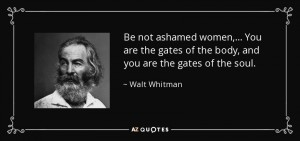Powerpoint: https://docs.google.com/presentation/d/1LuJLOFWOVU3QFOa_ZR8J5roVJhWUfscojtm5oFrourk/edit?ts=571d616b#slide=id.p4
Paper: https://docs.google.com/document/d/1O1DhgCgchk4ahtOUn5fOr_CqDKzhAhUWPORzSrNJUZk/edit
In “Women in Whitman’s Works” I examined Whitman’s portrayal of women, in light of feminist poet Adrienne Rich, to determine whether or not he serves as a feminist figure or as more of a product of his time. These poets appear similar in their political focus, communal vision, concern for the state, discussion of women’s bodies and desires, etc. Nevertheless, I argue that Whitman seeks to merge with woman and confines her to a preordained archetype. In doing so, I place him as a First Wave feminist, who believes woman should possess equal rights, yet does not represent her in her multi-faceted nature.
To demonstrate this divergence, I will analyze “Cartographies of Silence,” which recognizes female oppression, alongside “I Sing the Body Electric,” which utilizes a gendered “you” to discuss women. In Rich’s “Cartographies of Silence,” she discusses how absence of speech becomes a method of avoidance. Also, this lack of speech speaks volumes, in terms of flaws in the relationship the poem references, and in the the manner in which female oppression becomes neglected. Lines such as “silence can be a plan/rigorously executed” demonstrate how silence becomes utilized to remove oneself from a predicament (Rich 138). Meanwhile, Whitman’s “I Sing the Body Electric” strives to identity with woman without comprehension of her oppression. When Whitman praises mankind for its “[beauty”] and [“vigor”], he highlights man’s spiritual ascent but fails to include women without his communal “you” (Whitman 118). Through the lines “the sprawl and fulness of babes,” one can see how woman receives specific mention as linked to her maternal nature alone (Whitman 118). “Cartographies of Silence,” however, demonstrates the need for recognition of our gaps in language, and appears in stark contrast to Whitman’s omniscient voice. In his connection between the body and soul, Whitman assumes he possesses the ability to represent both sexes fully, from within a masculine perspective. For this reason, Whitman’s primitive feminism would receive improvement if it contained a genderless “you” and proved less assumptive in nature.

No comments yet.